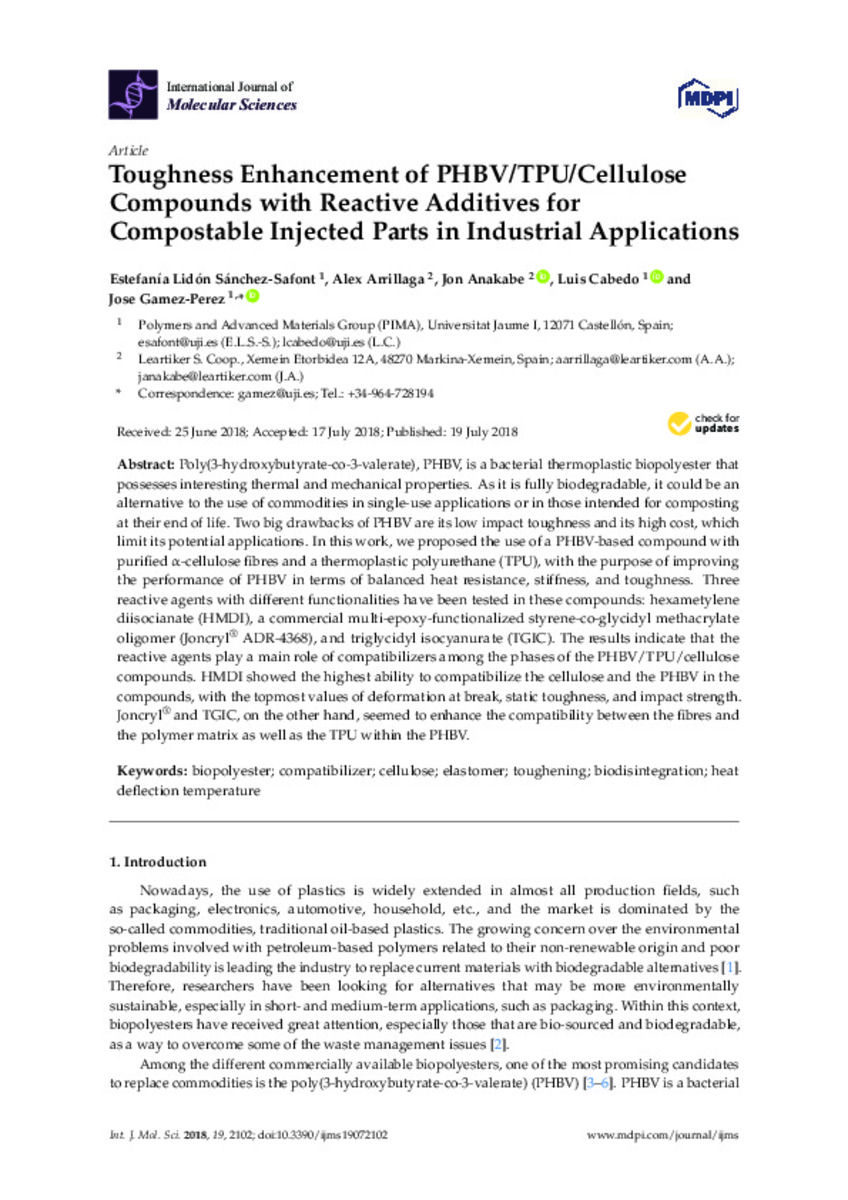Mostrar el registro sencillo del ítem
Toughness Enhancement of PHBV/TPU/Cellulose Compounds with Reactive Additives for Compostable Injected Parts in Industrial Applications
| dc.contributor.author | Sánchez-Safont, Estefanía | |
| dc.contributor.author | Arrillaga, Alex | |
| dc.contributor.author | Anakabe, Jon | |
| dc.contributor.author | Cabedo, Luis | |
| dc.contributor.author | Gamez-Perez, Jose | |
| dc.date.accessioned | 2018-11-13T07:57:14Z | |
| dc.date.available | 2018-11-13T07:57:14Z | |
| dc.date.issued | 2018-07 | |
| dc.identifier.citation | SÁNCHEZ-SAFONT, Estefanía, et al. Toughness Enhancement of PHBV/TPU/Cellulose Compounds with Reactive Additives for Compostable Injected Parts in Industrial Applications. International journal of molecular sciences, 2018, 19.7: 2102. | ca_CA |
| dc.identifier.uri | http://hdl.handle.net/10234/177411 | |
| dc.description.abstract | Poly(3-hydroxybutyrate-co-3-valerate), PHBV, is a bacterial thermoplastic biopolyester that possesses interesting thermal and mechanical properties. As it is fully biodegradable, it could be an alternative to the use of commodities in single-use applications or in those intended for composting at their end of life. Two big drawbacks of PHBV are its low impact toughness and its high cost, which limit its potential applications. In this work, we proposed the use of a PHBV-based compound with purified α-cellulose fibres and a thermoplastic polyurethane (TPU), with the purpose of improving the performance of PHBV in terms of balanced heat resistance, stiffness, and toughness. Three reactive agents with different functionalities have been tested in these compounds: hexametylene diisocianate (HMDI), a commercial multi-epoxy-functionalized styrene-co-glycidyl methacrylate oligomer (Joncryl® ADR-4368), and triglycidyl isocyanurate (TGIC). The results indicate that the reactive agents play a main role of compatibilizers among the phases of the PHBV/TPU/cellulose compounds. HMDI showed the highest ability to compatibilize the cellulose and the PHBV in the compounds, with the topmost values of deformation at break, static toughness, and impact strength. Joncryl® and TGIC, on the other hand, seemed to enhance the compatibility between the fibres and the polymer matrix as well as the TPU within the PHBV. | ca_CA |
| dc.format.extent | 20 p. | ca_CA |
| dc.format.mimetype | application/pdf | ca_CA |
| dc.language.iso | eng | ca_CA |
| dc.publisher | MDPI | ca_CA |
| dc.rights | © 2018 MDPI (Basel, Switzerland) unless otherwise stated | ca_CA |
| dc.rights | Atribución 4.0 Internacional | * |
| dc.rights.uri | http://creativecommons.org/licenses/by-sa/4.0/ | * |
| dc.subject | biopolyester | ca_CA |
| dc.subject | compatibilizer | ca_CA |
| dc.subject | cellulose | ca_CA |
| dc.subject | elastomer | ca_CA |
| dc.subject | toughening | ca_CA |
| dc.subject | biodisintegration | ca_CA |
| dc.subject | heat deflection temperature | ca_CA |
| dc.title | Toughness Enhancement of PHBV/TPU/Cellulose Compounds with Reactive Additives for Compostable Injected Parts in Industrial Applications | ca_CA |
| dc.type | info:eu-repo/semantics/article | ca_CA |
| dc.identifier.doi | https://doi.org/10.3390/ijms19072102 | |
| dc.relation.projectID | Ministerio de Economía y Competitividad (AGL2015-63855-C2-2-R) ; Promoció de la Investigació de la Universitat Jaume I (UJI-B2016-35) | ca_CA |
| dc.rights.accessRights | info:eu-repo/semantics/openAccess | ca_CA |
| dc.relation.publisherVersion | https://www.mdpi.com/1422-0067/19/7/2102 | ca_CA |
| dc.type.version | info:eu-repo/semantics/publishedVersion | ca_CA |
Ficheros en el ítem
Este ítem aparece en la(s) siguiente(s) colección(ones)
-
ESID_Articles [472]








